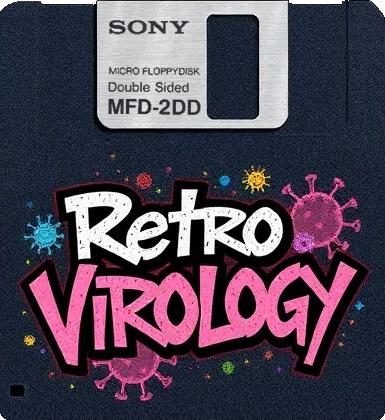Technical Overview of Atari ST Bootsector Viruses
The Atari ST's file system and low-level disk structure provided a unique attack surface for early computer viruses, particularly those targeting the File Allocation Table (FAT) and bootsector.
These viruses leveraged the intricate details of the Atari TOS (The Operating System) to propagate and hide malicious code.
Filesystem Architecture Vulnerabilities
The Atari ST used a FAT filesystem similar to early MS-DOS systems, with some key characteristics:
- Floppy disk format: Typically 9 sectors of 512 bytes per track
- Western Digital WD1772 Floppy Disk Controller
- Boot sector located in the first physical sector, 512 bytes, ~480 bytes usable
- Some MS-DOS BPB fields not used. BPB data encoded as Little Endian as it is the case for MS-DOS (while the ST is Big Endian)
Notable Viruses and Their Techniques
The Swiss Virus
Key Characteristics:
- Type: Memory-resident bootsector virus
- Other names: Blot virus, FAT virus
- Discovery Date: May 1st 1988 by Stephen E. Schneider.
- Origin: probably from Swiss hence the name
- Propagation: Copies to drive A
- Polymorphism: no
- Destructive Payload based on the unique loaded FAT sector:
- when
hz200counter has reached 3 hours, it will blackened the screen from top and bottom to middle
- when
- Infection Vector: Attaches to the
Hdv_bpb(hard drive parameter block), timer C,etv critic and reset vectors and undocumented resident routine. - Notes:
- the FAT sector code is only 170 bytes dedicated to replicate the FAT sector and trigger the symptoms.
- Works with German TOS 1.0 only due to
dskbufhardcoded address
The Beilstein Virus
Key Characteristics:
- Type: Reset-proof memory-resident bootsector virus
- Origin: written by a student from Beilstein, a town in South Germany (hence its name)
- Discovery Date: March 16th 1993 by Volker Söhnitz.
- Propagation: Copies to drive A
- Polymorphism: use dual encryption
-
Destructive Payload based on the loaded FAT sectors:
- Delete specific files when
MDISK,FCOPYIII,FCOPY3??,DISKUS,DISKDEMO,TED_???andG_COPY - Clear partition
Cof your hard disk when the virus in memory discovers that you are trying to trace it (trace bit set, for example in a debugger). - Create garbage on your screen.
- Keyboard, mouse and joystick disabled.
- Mouse movements inverted.
- Printer output corrupted.
- Modem output corrupted.
- A bomb error created.
- The system frozen until you enter the password "Apokalypse".
- Memory cleared, followed by a reset.
- The first hundred sectors of a floppy disk cleared.
- Delete a folder.
- Delete specific files when
-
Infection Vector: Uses undocumented reset-resistant vector and
Hdv_bpb,Vbl_queue,Hdv_rw,Hdv_boot,GEMDOS,XBIOS
The Lucky Lady 4.12 Virus
Key Characteristics:
- Type: Reset-proof memory-resident bootsector virus
- Origin: written by Lucky Lady from Slovenia.
- Discovery Date: March 1994 by Richard Karsmakers.
- Propagation: Copies to drive A
- Polymorphism: no
- Destructive Payload based on the loaded FAT sectors:
- It puts message "Lucky Lady forbids you to load the UVK!" on screen, then erases
UVK_x_x.PRGfiles from current drive when you try to load the "Ultimate Virus Killer" - Mouse cursor is changed from TOS arrow to Lucky Lady’s logo (LL) after approximately 35 minutes on monochrome (this takes a bit longer on colour).
- Screws up the screen
- Logical clusters 351 & 352 are overwritten and marked as ‘bad’ in the FAT (Every cluster entry after 351 is thus a "floating entry" if there was a file (data lost) present before on a disk)
- It puts message "Lucky Lady forbids you to load the UVK!" on screen, then erases
- Infection Vector:
Hdv_bpb,resvector,vbl_queue.
Technical Infection Mechanism
These viruses typically exploited the filesystem's structure by:
- Intercepting system vectors during boot process
- Hiding additional code in unused or hidden FAT sectors
- Modifying bootsector to ensure virus persistence
Virus Propagation Techniques
- Memory Residence: Staying active after system boot
- Disk Infection: Copying themselves to attached drives
- Vector Hijacking: Intercepting critical system interrupt vectors
Immunization and Detection
Antivirus tools like the Ultimate Virus Killer (UVK) 2000 could partially detect these viruses by:
- Checking specific memory offsets
- Verifying bootsector integrity
- Monitoring system vector modifications
But as far as I know, no antivirus was checking the FAT sectors to find malicious content, the Swiss and Beilstein viruses were recognized by identifying their bootsector loader.
Historical Context and Possible Lost FAT Virus
The most widespread virus of this era was the Signum/BPL Virus A, estimated to have infected approximately 1.5 million disks worldwide. This virus emerged during a period of limited system security and minimal antivirus protection. As this is a key virus, it was patiently waiting for his companion bootsector, the Key, to trigger the symptoms which may have been located on FAT sectors but as nobody found the key, it is justr speculaion.
Technical Significance
These Atari ST viruses represented an early example of:
- Sophisticated low-level filesystem manipulation
- Memory-resident malware techniques
- Exploiting operating system design vulnerabilities
Conclusion and resources
The FAT viruses on the Atari ST demonstrated the vulnerabilities inherent in early computer systems, showcasing how malicious actors could exploit filesystem structures to create persistent and potentially destructive malware.
This article explains the BPB structure and how FAT sectors are defined: - Q140418: Detailed Explanation of FAT Boot Sector

